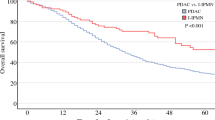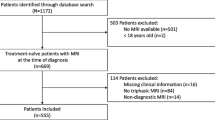Abstract
Purpose
On computed tomography (CT), intrahepatic cholangiocarcinomas (ICC) are a visibly heterogeneous group of tumors. The purpose of this study was to investigate the associations between CT imaging phenotypes, patient survival, and known genetic markers.
Methods
A retrospective study was performed with 66 patients with surgically resected ICC. Pre-surgical CT images of ICC were assessed by radiologists blinded to tumor genetics and patient clinical data. Associations between qualitative imaging features and overall survival (OS) and disease-free survival (DFS) were performed with Cox proportional hazards regression and visualized with Kaplan–Meier plots. Associations between radiographic features and genetic pathways (IDH1, Chromatin and RAS-MAPK) were assessed with Fisher’s Exact test and the Wilcoxon Rank sum test where appropriate and corrected for multiple comparisons within each pathway using the False Discovery Rate correction.
Results
Three imaging features were significantly associated with a higher risk of death: necrosis (hazard ratio (HR) 2.95 95% CI 1.44–6.04, p = 0.029), satellite nodules (HR 3.29, 95% CI:1.35–8.02, p = 0.029), and vascular encasement (HR 2.63, 95% CI 1.28–5.41, p = 0.029). Additionally, with each increase in axial size, the risk of death increased (HR 1.14, 95% CI 1.03–1.26, p = 0.029). Similar to findings for OS, satellite nodules (HR 3.81, 95% CI 1.88–7.71, p = 0.002) and vascular encasement (HR 2.25, 95% CI 1.24–4.06, p = 0.019) were associated with increased risk of recurrence/death. No significant associations were found between radiographic features and genes in the IDH1, Chromatin or RAS-MAPK pathways (p = 0.63–84).
Conclusion
This preliminary analysis of resected ICC suggests associations between CT imaging features and OS and DFS. No association was identified between imaging features and currently known genetic pathways.



Similar content being viewed by others
References
Blechacz B, Komuta M, Roskams T, Gores GJ (2011) Clinical diagnosis and staging of cholangiocarcinoma. Nat Rev Gastroenterol Hepatol 8(9):512–522. https://doi.org/10.1038/nrgastro.2011.131
Mar WA, Shon AM, Lu Y, et al. (2016) Imaging spectrum of cholangiocarcinoma: role in diagnosis, staging, and posttreatment evaluation. Abdom Radiol 41(3):553–567. https://doi.org/10.1007/s00261-015-0583-9
Yamasaki S (2003) Intrahepatic cholangiocarcinoma: macroscopic type and stage classification. J Hepato-Biliary-Pancreat Surg 10(4):288–291. https://doi.org/10.1007/s00534-002-0732-8
Khan SA, Toledano MB, Taylor-Robinson SD (2008) Epidemiology, risk factors, and pathogenesis of cholangiocarcinoma. HPB 10(2):77–82. https://doi.org/10.1080/13651820801992641
Park J, Kim MH, Kim KP, et al. (2009) Natural history and prognostic factors of advanced cholangiocarcinoma without surgery, chemotherapy, or radiotherapy: a large-scale observational study. Gut Liver 3(4):298–305. https://doi.org/10.5009/gnl.2009.3.4.298
Doussot A, Gonen M, Wiggers JK, et al. (2016) Recurrence patterns and disease-free survival after resection of intrahepatic cholangiocarcinoma: preoperative and postoperative prognostic models. J Am Coll Surg 223(3):493–505. https://doi.org/10.1016/j.jamcollsurg.2016.05.019
Xie B, Tomaszewski MR, Neves A, et al. (2017) Optoacoustic detection of early therapy-induced tumor cell death using a targeted imaging agent. Clin Cancer Res . https://doi.org/10.1158/1078-0432.ccr-17-1029
Kuo MD, Yamamoto S (2011) Next generation radiologic-pathologic correlation in oncology: rad-Path 2.0. AJR. Am J Roentgenol 197(4):990–997. https://doi.org/10.2214/ajr.11.7163
Gillies RJ, Kinahan PE, Hricak H (2016) Radiomics: images are more than pictures, they are data. Radiology 278(2):563–577. https://doi.org/10.1148/radiol.2015151169
Elsayes KM, Kielar AZ, Agrons MM, et al. (2017) Liver imaging reporting and data system: an expert consensus statement. J Hepatocell Carcinoma 4:29–39. https://doi.org/10.2147/jhc.s125396
Kim SA, Lee JM, Lee KB, et al. (2011) Intrahepatic mass-forming cholangiocarcinomas: enhancement patterns at multiphasic CT, with special emphasis on arterial enhancement pattern–correlation with clinicopathologic findings. Radiology 260(1):148–157. https://doi.org/10.1148/radiol.11101777
Konstantinidis IT, Do RK, Gultekin DH, et al. (2014) Regional chemotherapy for unresectable intrahepatic cholangiocarcinoma: a potential role for dynamic magnetic resonance imaging as an imaging biomarker and a survival update from two prospective clinical trials. Ann Surg Oncol 21(8):2675–2683. https://doi.org/10.1245/s10434-014-3649-y
Turkoglu MA, Yamamoto Y, Sugiura T, et al. (2016) The favorable prognosis after operative resection of hypervascular intrahepatic cholangiocarcinoma: a clinicopathologic and immunohistochemical study. Surgery 160(3):683–690. https://doi.org/10.1016/j.surg.2016.03.020
Fujita N, Asayama Y, Nishie A, et al. (2017) Mass-forming intrahepatic cholangiocarcinoma: enhancement patterns in the arterial phase of dynamic hepatic CT—Correlation with clinicopathological findings. Eur Radiol 27(2):498–506. https://doi.org/10.1007/s00330-016-4386-3
Zhu AX, Borger DR, Kim Y, et al. (2014) Genomic profiling of intrahepatic cholangiocarcinoma: refining prognosis and identifying therapeutic targets. Ann Surg Oncol 21(12):3827–3834. https://doi.org/10.1245/s10434-014-3828-x
Nakamura H, Arai Y, Totoki Y, et al. (2015) Genomic spectra of biliary tract cancer. Nat Genet 47(9):1003–1010. https://doi.org/10.1038/ng.3375
Moeini A, Sia D, Bardeesy N, Mazzaferro V, Llovet JM (2016) Molecular pathogenesis and targeted therapies for intrahepatic cholangiocarcinoma. Clin Cancer Res 22(2):291–300. https://doi.org/10.1158/1078-0432.ccr-14-3296
Sia D, Hoshida Y, Villanueva A, et al. (2013) Integrative molecular analysis of intrahepatic cholangiocarcinoma reveals 2 classes that have different outcomes. Gastroenterology 144(4):829–840. https://doi.org/10.1053/j.gastro.2013.01.001
Cheng DT, Mitchell TN, Zehir A, et al. (2015) Memorial sloan kettering-integrated mutation profiling of actionable cancer targets (MSK-IMPACT): a hybridization capture-based next-generation sequencing clinical assay for solid tumor molecular oncology. J Mol Diagn 17(3):251–264. https://doi.org/10.1016/jmoldx.2014.12.006j
Cerami E, Gao J, Dogrusoz U, et al. (2012) The cBio cancer genomics portal: an open platform for exploring multidimensional cancer genomics data. Cancer Discovery 2(5):401–404. https://doi.org/10.1158/2159-8290.cd-12-0095
Gao J, Aksoy BA, Dogrusoz U, et al. (2013) Integrative analysis of complex cancer genomics and clinical profiles using the cBioPortal. Sci Signal 6(269):pl1. https://doi.org/10.1126/scisignal.2004088
Jiao Y, Pawlik TM, Anders RA, et al. (2013) Exome sequencing identifies frequent inactivating mutations in BAP1, ARID1A and PBRM1 in intrahepatic cholangiocarcinomas. Nat Genet 45(12):1470–1473. https://doi.org/10.1038/ng.2813
Baheti AD, Tirumani SH, Shinagare AB, et al. (2014) Correlation of CT patterns of primary intrahepatic cholangiocarcinoma at the time of presentation with the metastatic spread and clinical outcomes: retrospective study of 92 patients. Abdom Imaging 39(6):1193–1201. https://doi.org/10.1007/s00261-014-0167-0
Segal E, Sirlin CB, Ooi C, et al. (2007) Decoding global gene expression programs in liver cancer by noninvasive imaging. Nat Biotechnol 25(6):675–680. https://doi.org/10.1038/nbt1306
Diehn M, Nardini C, Wang DS, et al. (2008) Identification of noninvasive imaging surrogates for brain tumor gene-expression modules. Proc Natl Acad Sci USA 105(13):5213–5218. https://doi.org/10.1073/pnas.0801279105
Nair VS, Gevaert O, Davidzon G, et al. (2012) Prognostic PET 18F-FDG uptake imaging features are associated with major oncogenomic alterations in patients with resected non-small cell lung cancer. Cancer Res 72(15):3725–3734. https://doi.org/10.1158/0008-5472.can-11-3943
Gatenby RA, Grove O, Gillies RJ (2013) Quantitative imaging in cancer evolution and ecology. Radiology 269(1):8–15. https://doi.org/10.1148/radiol.13122697
Gevaert O, Xu J, Hoang CD, et al. (2012) Non-small cell lung cancer: identifying prognostic imaging biomarkers by leveraging public gene expression microarray data–methods and preliminary results. Radiology 264(2):387–396. https://doi.org/10.1148/radiol.12111607
Yamamoto S, Maki DD, Korn RL, Kuo MD (2012) Radiogenomic analysis of breast cancer using MRI: a preliminary study to define the landscape. AJR 199(3):654–663. https://doi.org/10.2214/ajr.11.7824
Zinn PO, Mahajan B, Sathyan P, et al. (2011) Radiogenomic mapping of edema/cellular invasion MRI-phenotypes in glioblastoma multiforme. PLoS ONE 6(10):e25451. https://doi.org/10.1371/journal.pone.0025451
Karlo CA, Di Paolo PL, Chaim J, et al. (2014) Radiogenomics of clear cell renal cell carcinoma: associations between CT imaging features and mutations. Radiology 270(2):464–471. https://doi.org/10.1148/radiol.13130663
Banerjee S, Wang DS, Kim HJ, et al. (2015) A computed tomography radiogenomic biomarker predicts microvascular invasion and clinical outcomes in hepatocellular carcinoma. Hepatol 62(3):792–800. https://doi.org/10.1002/hep.27877
Taouli B, Hoshida Y, Kakite S, et al. (2017) Imaging-based surrogate markers of transcriptome subclasses and signatures in hepatocellular carcinoma: preliminary results. Eur Radiol . https://doi.org/10.1007/s00330-017-4844-6
Sadot E, Simpson AL, Do RK, et al. (2015) Cholangiocarcinoma: correlation between molecular profiling and imaging phenotypes. PLoS ONE 10(7):e0132953. https://doi.org/10.1371/journal.pone.0132953
Borger DR, Tanabe KK, Fan KC, et al. (2012) Frequent mutation of isocitrate dehydrogenase (IDH)1 and IDH2 in cholangiocarcinoma identified through broad-based tumor genotyping. Oncol 17(1):72–79. https://doi.org/10.1634/theoncologist.2011-0386
Robertson S, Hyder O, Dodson R, et al. (2013) The frequency of KRAS and BRAF mutations in intrahepatic cholangiocarcinomas and their correlation with clinical outcome. Human Pathol 44(12):2768–2773. https://doi.org/10.1016/j.humpath.2013.07.026
Wang P, Dong Q, Zhang C, et al. (2013) Mutations in isocitrate dehydrogenase 1 and 2 occur frequently in intrahepatic cholangiocarcinomas and share hypermethylation targets with glioblastomas. Oncogene 32(25):3091–3100. https://doi.org/10.1038/onc.2012.315
Churi CR, Shroff R, Wang Y, et al. (2014) Mutation profiling in cholangiocarcinoma: prognostic and therapeutic implications. PLoS ONE 9(12):e115383. https://doi.org/10.1371/journal.pone.0115383
Jusakul A, Cutcutache I, Yong CH, et al. (2017) Whole-genome and epigenomic landscapes of etiologically distinct subtypes of cholangiocarcinoma. Cancer Discov 7(10):1116–1135. https://doi.org/10.1158/2159-8290.cd-17-0368
Author information
Authors and Affiliations
Corresponding author
Ethics declarations
Funding
Linda M. Pak, MD, was supported by the Clinical and Translational Science Center at Weill Cornell Medical Center and MSKCC Award Number UL1TR00457. This work was also supported in part by NIH/NCI P30 CA008748 Cancer Center Support Grant.
Conflict of interest
The authors declare that they have no conflict of interest.
Ethical approval
All procedures performed in studies involving human participants were in accordance with the ethical standards of the institutional and/or national research committee and with the 1964 Helsinki declaration and its later amendments or comparable ethical standards. This article does not contain any studies with animals performed by any of the authors.
Informed consent
For this type of study formal consent is not required.
Rights and permissions
About this article
Cite this article
Aherne, E.A., Pak, L.M., Goldman, D.A. et al. Intrahepatic cholangiocarcinoma: can imaging phenotypes predict survival and tumor genetics?. Abdom Radiol 43, 2665–2672 (2018). https://doi.org/10.1007/s00261-018-1505-4
Published:
Issue Date:
DOI: https://doi.org/10.1007/s00261-018-1505-4




